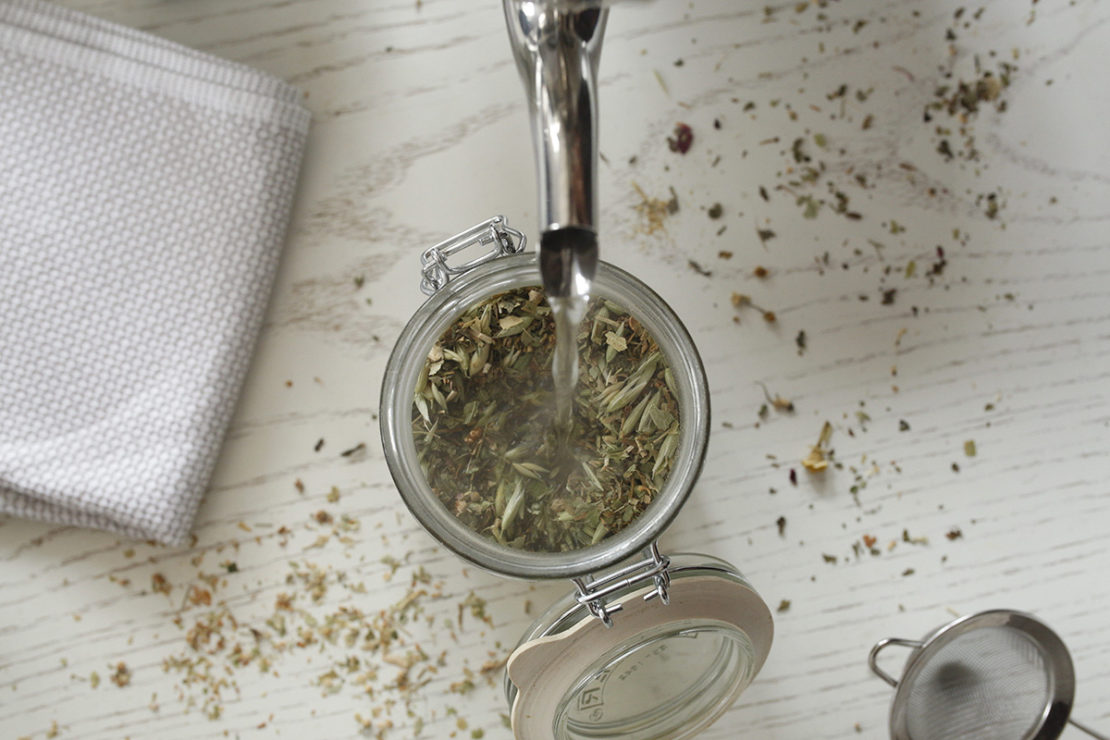
How To Build A Nutritive Tea
While many of us search the supplement aisles to round out our nutritional needs, we often forget about the many herbs out there that are not only rich in vitamins and minerals but also aid in our absorption of certain nutrients. Now I’m not telling you to throw all your supplements in the trash! However, consider adding a daily nutritive tea to your regular wellness practices for a herbal nutritional boost.
I often relate to my clients that nutritive teas can help fill in “nutritional holes” in our daily diet. These are easily overlooked, and boosting our daily nutritional intake can make a big impact on certain imbalances we may be dealing with. Read on to discover how to build a nutritive tea at home!
Nutritive Herbs
Here is a list of some basic nutritive herbs to draw from when you build a nutritive tea. There are many other nutritive herbs you can use as well, just be sure to do your research to see how they will fit into your formula and with your personal health picture.
Alfalfa (Medicago farfara)
Alfalfa is a classic nutritive herb used since the early days of traditional Greek medicine for its nutrient boosting and nourishing properties (Holmes, 1989). Its moistening nature and mild grassy flavor make it palatable, and easy to balance in flavor with other herbs when formulating. Alfalfa is a broad spectrum nutritive herb rich in vitamins A, B1, B2, B2, B5, B6, B12, C, D, E, and K, calcium, cobalt, iron, and magnesium (Pedersen, 1987; Young, n.d.).
When taken with a meal, alfalfa can promote nutrient absorption of calcium and protein in particular (Holmes, 1989). It also aids in overall digestion and our body’s ability to break down nutrients by encouraging the release of gastric secretions. Alfalfa is considered a very safe nutritive herb that also contains blood building properties. (Learn more about nourishing the blood in our post here.)
Nettle (Urtica dioica)
Nettle is a staple nutritive herb you may already have incorporated into your practice, or maybe even stung yourself on accident in the field! Its nutritive qualities are largely due to its high content of trace minerals, chlorophyll, proteins, and the enzyme secretin (Holmes, 1989). Nettle is also a great source of vitamin A, B1, B2, B3, B5, C, D, E, K, calcium, chromium, cobalt, magnesium, manganese, phosphorus, potassium, selenium, silicon, and zinc (Pedersen, 1987; Young, n.d.).
Nettle is naturally sweet and nourishing and also makes a fabulous blood builder. Since nettle is drying in nature, be sure to balance this energetic with a moistening herb(s) when you build a nutritive tea. Despite the fact that you use the aerial parts, nettle’s beneficial properties are extracted best when lightly decocted. When building a nutritive tea with nettle, be sure to use an overnight infusion method to extract its minerals. (Read more about nettle in our post here.)
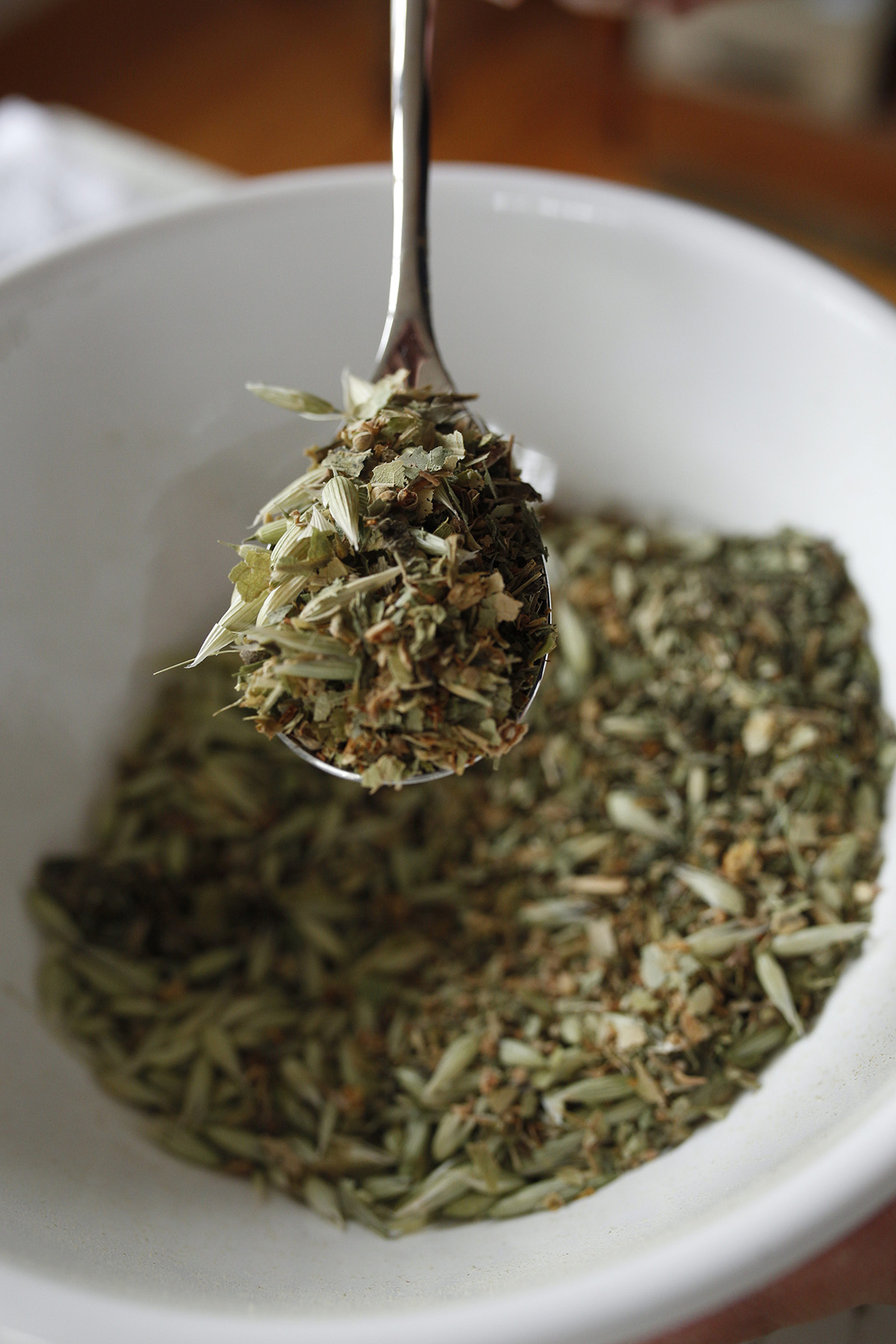
Oatstraw or Oat Tops (Avena sativa)
Oatstraw and oat tops (also known as “milky oats”) have a slightly sweet, smooth, and comforting taste and are moistening in nature. According to Ayurveda, oat’s naturally sweet flavor indicates its restorative qualities which help promote physical strength, weight gain and growth, and protein anabolism enhancement (Holmes, 1989). The key nutrients in oats are vitamin A, B1, B2, B3, B6, C, E, K, calcium, chromium, iron, magnesium, silicon, and selenium (Pedersen, 1987; Young, n.d.).
Since oatstraw and tops are considered safe nutritive builders, they are commonly used with children, the elderly, and long-term for people in extremely deficient states. Oats are also well known for offering soothing nervous system support and helping calm anxious minds. (Get to know more about oats in our post here.)
Red Clover (Trifolium pratense)
Red clover has many beneficial properties including being a staple nutritive herb. Its energetics are slightly mixed between being moist and dry, while taste-wise it has subtle sweetness and underlying “jammy” note. Some of the nutrients red clover is noted for are vitamin A, B1, B2, B3, C, calcium, chromium, magnesium, manganese, molybdenum, phosphorus, potassium, and other trace minerals (Pedersen, 1987; Young, n.d.).
From the perspective of Traditional Chinese Medicine (TCM), red clover helps nourish our yin, blood, and fluids, which, in turn, helps the blood carry more nutrients throughout the body (Holmes, 1989). This makes it a great addition when building a nutritive tea for helping balance nutritional deficiencies. (Learn more about red clover in our post here.)
Raspberry Leaf (Rubus idaeus)
Well known for its female reproductive system supportive properties, raspberry leaf is also a broad-spectrum nutritive herb. Raspberry leaf is rich in calcium, iron, and magnesium in addition to vitamins A, B1, B2, B3, C, E, manganese, niacin, selenium, and other trace minerals (Pedersen, 1987; Gladstar, 2001; Young, n.d.).
Note that because it is quite astringent in nature, you’ll want to balance it with other herbs when you use it to build a nutritive tea (Holmes, 1989). (Learn more in our post 3 Raspberry Leaf Benefits For Women.)
Dandelion Leaf (Taraxacum officinale)
The key nutrients in dandelion leaf are vitamin A, C, E, calcium, iron, magnesium, potassium, and zinc (Young, n.d.; Holmes, 1989; Tierra, 1988). Not only is dandelion leaf a stellar nutritive herb, its bitter quality also makes it a fabulous herb for supporting and stimulating digestion.
Since dandelion leaf is quite bitter and can be diuretic in nature (and you want to make sure you assimilate your nutrients, not just pee them all out!), it’s best to use it as a supporting herb when you build a nutritive tea formula. (Read our post, All About Dandelion (For Your Materia Medica) here.)
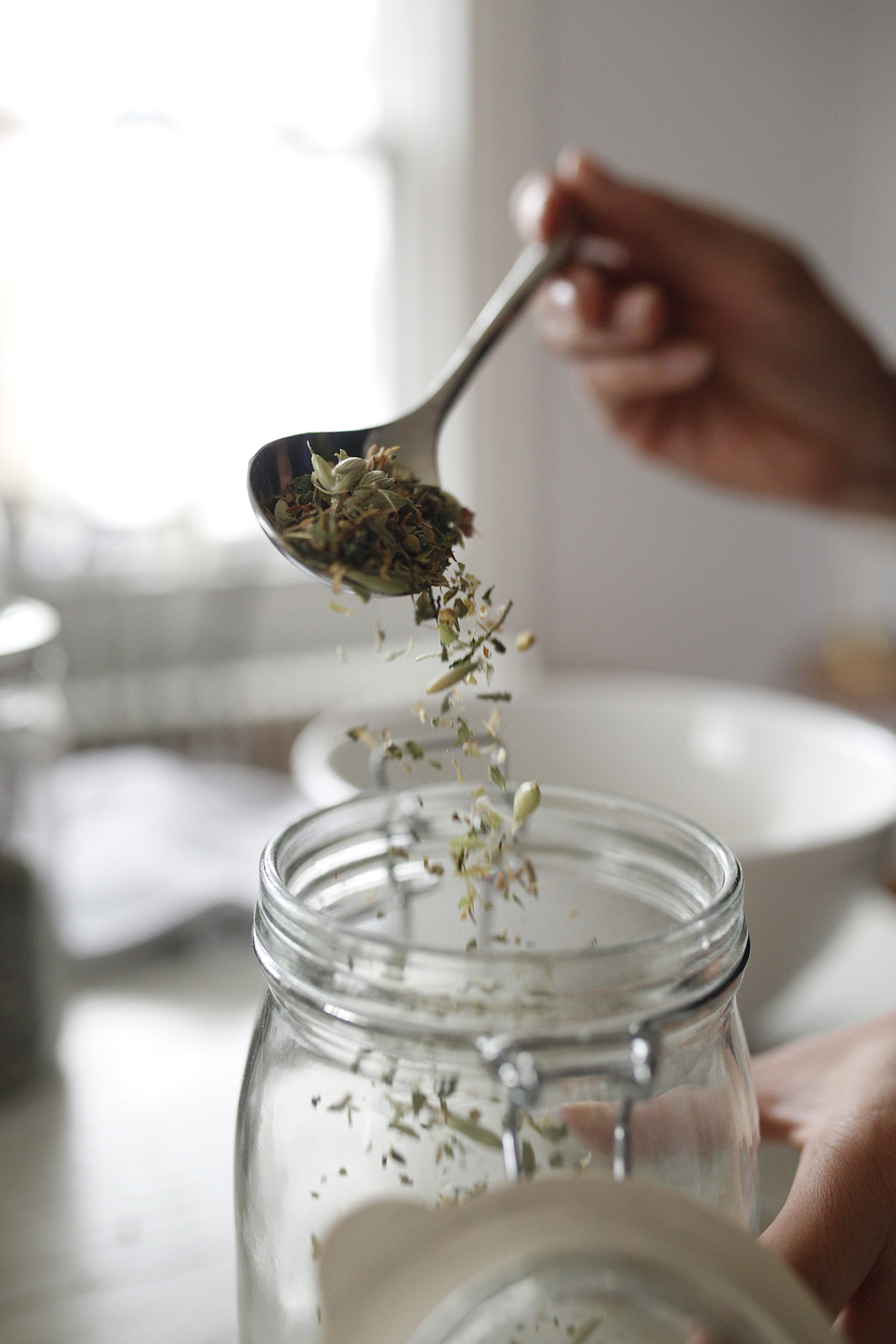
Horsetail (Equisetum arvense)
Rich in silica, horsetail is a nutritive herb commonly used for supporting the growth of tissues, bones, hair, skin, and nails. Horsetail is also replete with vitamin A, calcium, chromium, iron, magnesium, manganese, and potassium (Pedersen, 1987).
As for energetics, horsetail is cold, dry, and somewhat bitter so be sure to balance appropriately when you build a nutritive tea (Holmes, 1989). Given its high silica content, which can create urinary irritation in some, horsetail should not be taken for more than several weeks at a time (Holmes, 1989).
Chickweed (Stellaria media)
Chickweed has a neutral and slightly grassy flavor with moistening qualities (Tierra, 1988). Although you might have guessed this from the name, chickweed is a prolific weed! It helps promote nutrient absorption and nourishes the blood (Holmes, 1989).
Rich in vitamin A, calcium, iron, magnesium, manganese, potassium, silicon, zinc, and other trace minerals, chickweed is a premier nutritive and restorative herb (Pedersen, 1987; Holmes, 1989). Best of all, it is safe and gentle enough for the whole family.
Violet (Viola spp.)
Violet is a common nutritive herb that is well-known for its beautiful, edible flowers. Although the flowers are lovely, the core nutritive value lies in the leaves. The key nutrients in violet include vitamin A, vitamin C, and calcium (Young, n.d.).
Bonus: violet is also known to have a relaxing effect that helps soothe frayed nerves and restlessness (De Bairacli Levy, 1997). (Learn more about The Virtues of Violets in our post here.)
Flavor-Harmonizing Herbs
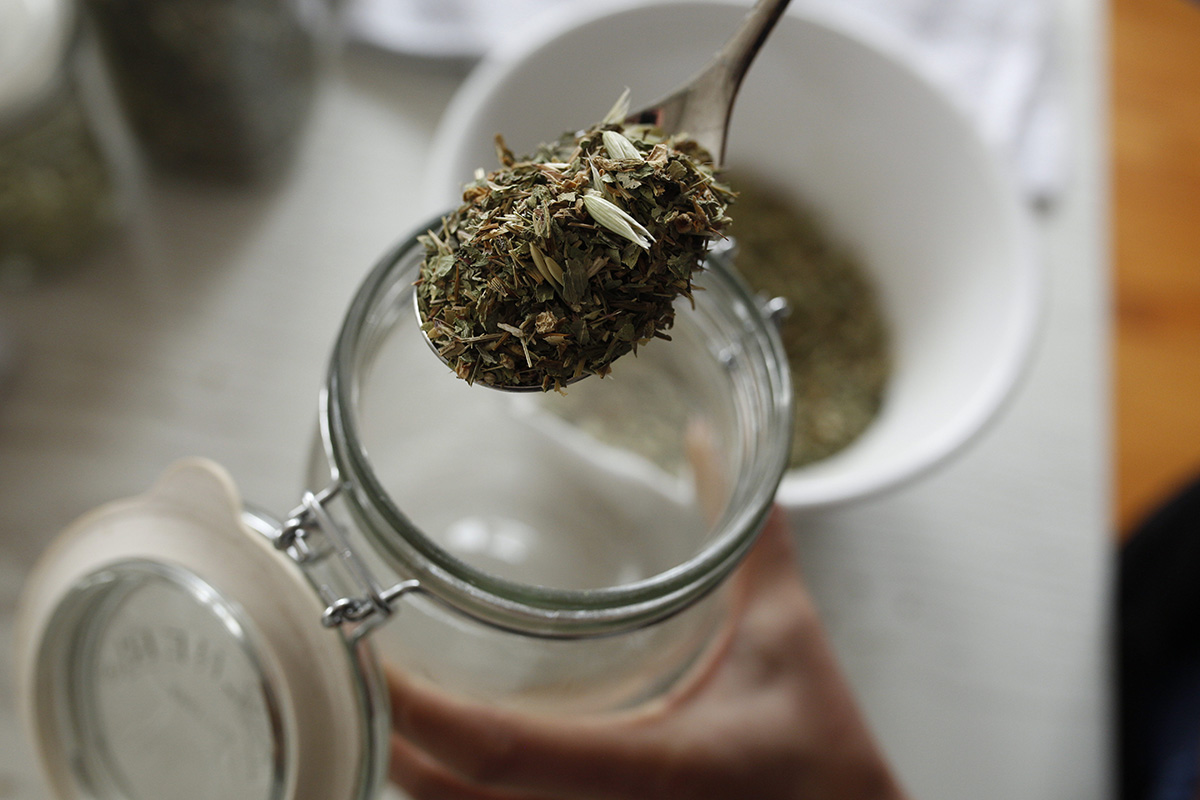
While you can enjoy your nutritive tea without boosting the taste, sometimes adding a flavor harmonizer can really pull the formula together. Most of the nutritive herbs above tend to be neutral in taste so adding a touch of flavor or sweetness can be a nice complement. Here are 3 common flavor harmonizing herbs you can consider using when you build a nutritive tea:
Licorice (Glycyrrhiza glabra)
A favorite natural herbal sweetener of many herbalists, licorice root lends its distinctly sweet accent well to nutritive tea blends. In addition, it is soothing to the respiratory system and the gut. Opt for the shredded root or small chopped root pieces rather than those that are longer and uncut. Since you are not decocting your nutritive tea, these forms will extract better in a simple or overnight infusion.
Spearmint (Mentha spicata) or Peppermint (Mentha piperita)
Mint is a great flavor addition for a nutritive tea. Spearmint is slightly sweeter and lighter in nature, while peppermint is a bit spicier and stronger. Both of these mints also direct a slight focus on digestion.
Cinnamon Chips (Cinnamomum spp.)
Incorporating cinnamon chips in your nutritive tea formula offers a subtly sweet and spicy flavor. When used in a small amount in your nutritive tea blend, cinnamon does not overpower the flavor but becomes a lovely accent. In addition, cinnamon can help blood sugar levels stay balanced (Holmes, 1989).
How to Build a Nutritive Tea
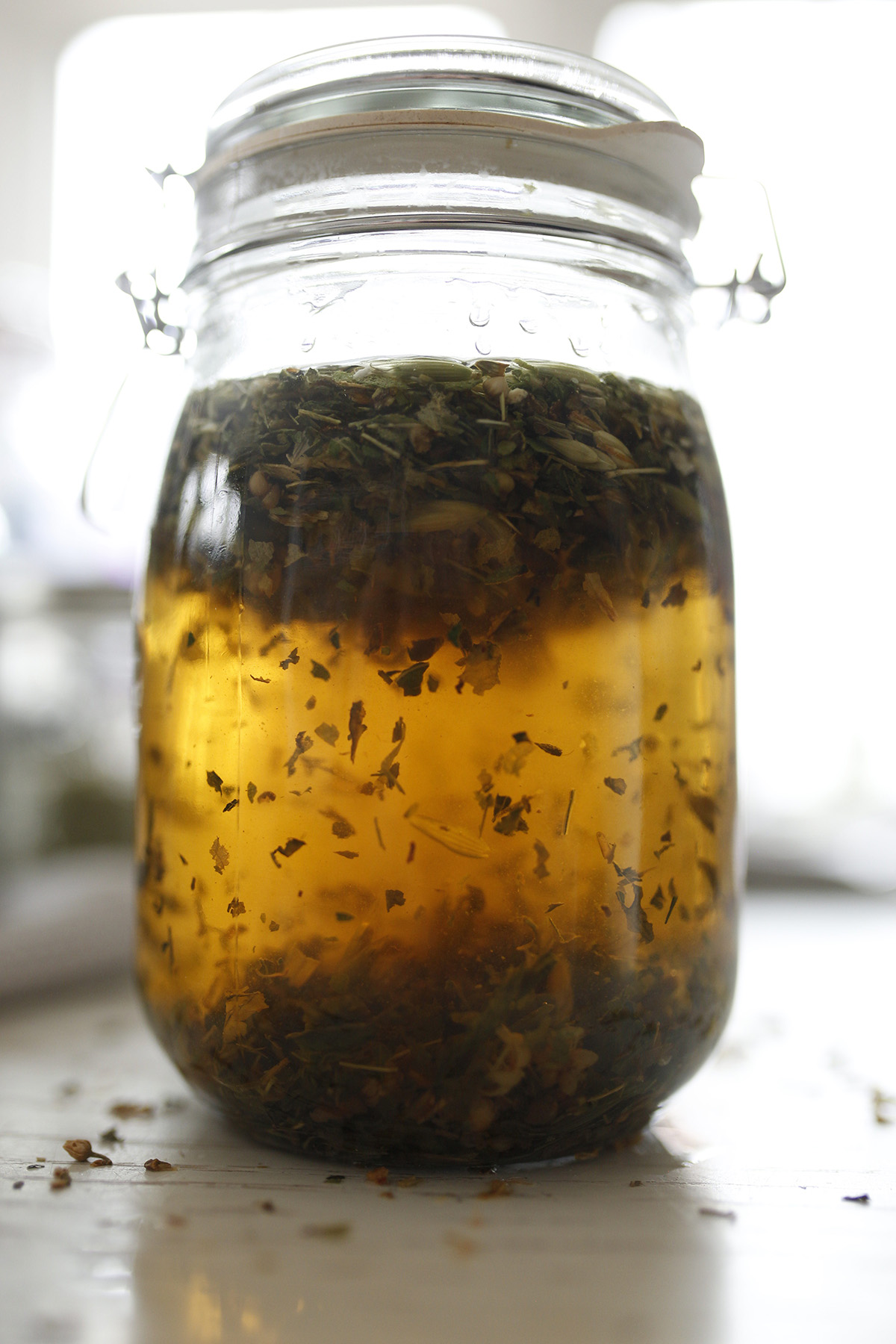
Although there are many different herbs you can draw from, building a nutritive tea can be a simple, fun, and intuitive process once you get the basics covered. Here are a few detailed steps you can follow to help guide your tea building process:
1. Choose your herbs. When building a balanced tea formula, it is generally recommended to use up to 7 different herbs. You can always reduce or add to this list later on. Although you can still make a great formula with more than 7 herbs, or even just 2 herbs, sometimes the focus of your formula can become lost or the properties of the herbs can become repetitive when too many different herbs are involved.
Sometimes it can be hard as herbalists to cut out herbs from formulas because we love and want to use them ALL! But remember that formulation is simply experimentation. And you can also re-formulate in the next batch you make, observing any changes in flavor, energetics, and herbal actions as you play around.
2. Select your primary herbs. Once you list all of the herbs you want to use, pick 1-2 of those herbs to be your primary or leading herbs in the nutritive tea. Your primary herbs are the core focus of the formula while the rest of the herbs you choose support or guide their focus. While these herbs do not have to be the ones you use in the greatest quantity of in the formula, oftentimes they are.
3. List the energetics + specific actions of each herb. List the energetics of each herb on your list followed by any particular action(s) you want to use the herb for in this formula. When you build a nutritive tea formula, you might want to pay attention to specific nutrients you are looking for in different herbs and write them here as well.
4. Compare your herbs and adjust your formula. Based on the list of actions and energetics you just made, compare all of your herbs for any redundancies between them. It is fine to have some overlap in action, but you can use those parallels to remove certain herbs from your formula, too. You can also factor in the accessibility, price, and availability of the herbs here as well.
5. Proportion your herbs. Once you have your list finalized, you can start to proportion your herbs in parts. This step takes some practice and refining over time so be easy on yourself the first couple times you try it! When deciding the ratio of parts, some things to consider are: whether the herb is primary, secondary, or tertiary (flavor enhancing herbs are tertiary when you build a nutritive tea), energetic balance (balancing a dry herb with a moistening one for instance), and the general flavor of the herbs individually and the blend as a whole.
Next to each herb write how many parts of it you would like to use in your nutritive tea formula. For instance: if alfalfa is one of your primary herbs, you might use 2 parts; if you only want a touch of sweetness from licorice, you might use ¼ to ½ of a part. Be sure to compare all of the parts once you finalize the list and make any additional adjustments as you see fit. (You can learn more about what “parts” are here.)
6. Determine the exact quantities (optional). If you want your formula to be proportionally exact, follow this step to determine the exact quantity of the herbs you use. This step is optional since once you have your parts determined, you can also just use the folk method of approximating parts using measuring spoons and cups.
When determining the exact quantities, start by deciding the total quantity of nutritive tea you want to have at the end. Then divide this number by the total number of parts (down to the decimal if you used ½ of a part, for instance). The number that this simple equation gets you is the number you then multiply individually by each part.
Example: You are building a nutritive tea with 2 parts of alfalfa and ½part of licorice. This equals 2.5 parts total. You want 30 grams total of nutritive tea. Divide 30 by 2.5 to get 12. Then multiply 12 by 2 part alfalfa to get 24: you will use 24 grams of alfalfa in your formula. Multiply 12 by ½ part licorice to get 6: you will use 6 grams of licorice in your formula. 24 + 6 = 30 grams (your desired total amount of nutritive tea blend).
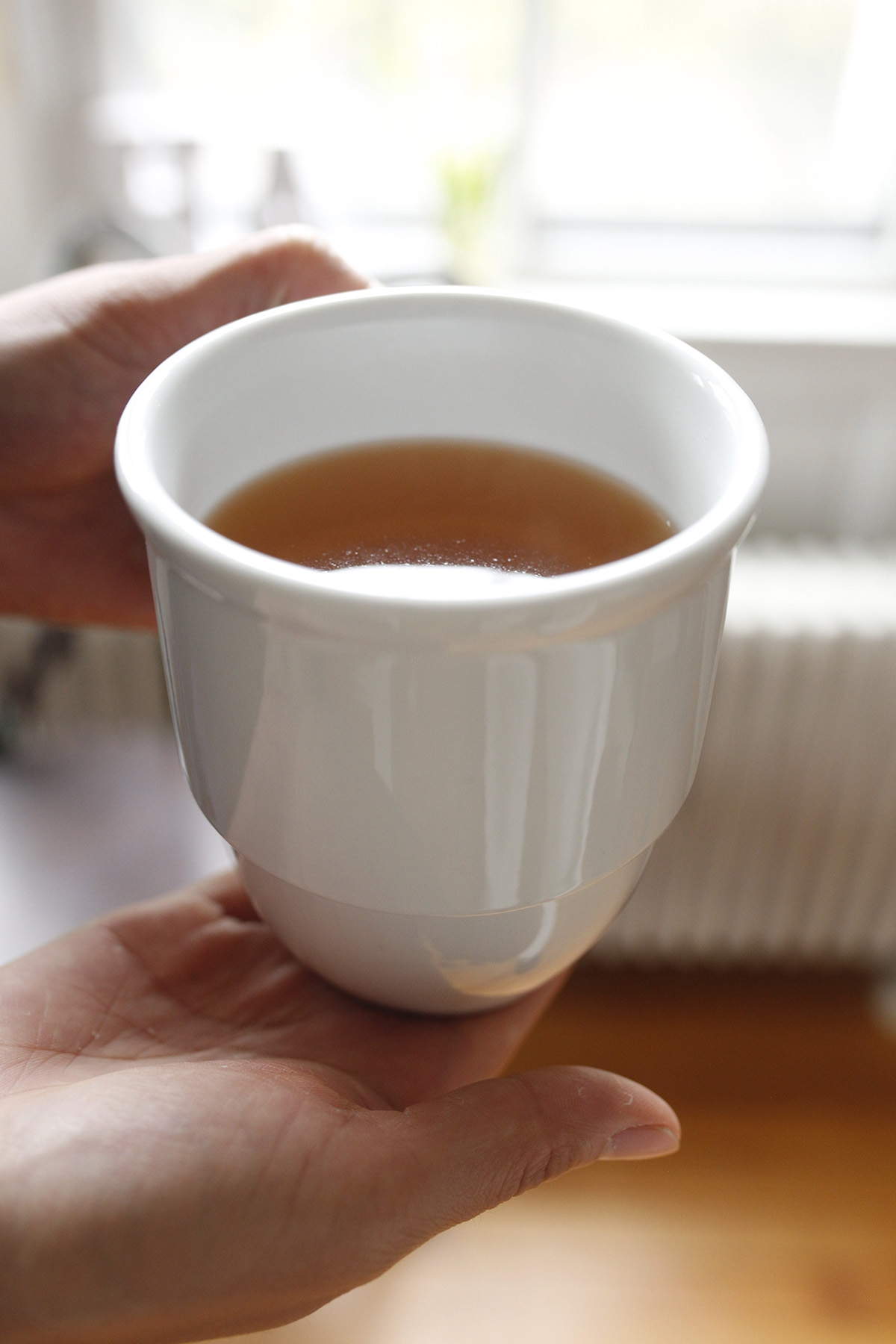
Nourishing Daily Practice
For many herbalists and tea lovers, drinking a daily nutritive tea becomes an enjoyable and nourishing daily practice. The nutrients in herbal teas are arguably more bioavailable and concentrated than tinctures and powdered herbal supplements too which helps keep us inspired to keep drinking (Groves, 2016).
Since nutritive herbs tend to be gentle in nature and milder in taste, many clinical herbalists recommend drinking a quart per day for several months. Be sure to note any herbs you include in your formula that might not be indicated for long-term use without taking a break in between (such as horsetail), and alternate between a formula that includes those herbs and one that does not.
In general, the longer the herbs steep, the more nutrients can be extracted, so doing an overnight infusion or letting the herbs continue steeping all day as you sip the infusion with a tea straw are both great options (Groves, 2016). The standard ratio used is 20-28 grams (or roughly 4-6 heaping tablespoons) of herb to 4 cups of freshly boiled water, but you can use up to a cup (approximately 16 tablespoons of leafy herb) for an even stronger brew.
A Nutritive Note
It is important to remember that nutritive herbal tea can help fill in the gaps with nutrient imbalances but that the exact vitamin and mineral content extracted is variable herb-to-herb and each time you brew. When in doubt, consult your clinical herbalist for a second opinion and go to your primary care physician to test for specific nutrient deficiencies or other concerns.
Now comes the fun part! Formulating and experimenting with different herbs to build a nutritive tea is always exciting and ever nourishing. Be sure to share your photos and recipes with us by tagging us on social media using hashtags #herbalacademy or #myherbalstudies.
Learn more about combining the art of drinking nutritive tea with other herbal practices in my post 6 Steps To Revitalize Your Health With Herbs This Spring.
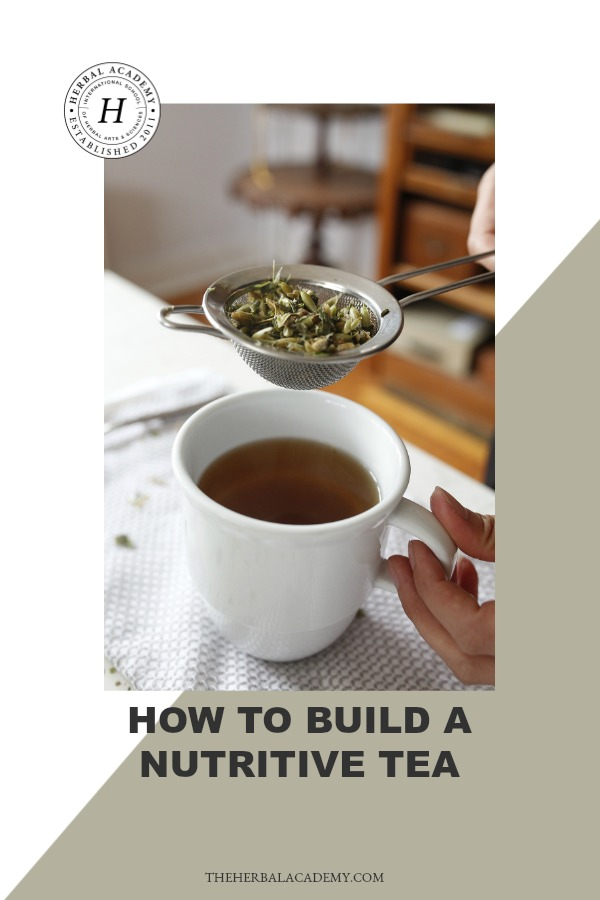
REFERENCES
De Bairacli Levy, J. (1997). Common herbs for natural health. Woodstock, NY: Ash Tree Publishing.
Holmes, P. (1989). The energetics of western herbs. Cotati, CA: Snow Lotus Press.
Gladstar, R. (2001). Rosemary gladstar’s family herbal. North Adams, MA: Storey Publishing.
Groves, M.N. (2016). Body into balance: An herbal guide to holistic self-care. North Adams, MA: Storey Publishing.
Pedersen, M. (1987). Nutritional herbology: A reference guide to herbs. Warsaw, IN: Whitman Publications.
Tierra, M. (1988). Planetary herbology. Twin Lakes, WI: Lotus Press.
Young, C. (n.d.). Just say no to synthetic vitamins and processed foods! [Online Article]. Retrieved from: http://www.susunweed.com/herbal_ezine/May05/healingwise.htm.








